Advanced finger placement for DP (by ERETER)
DP Intermediate
DP Advanced
This is a direct translation of ereter’s article by Horie.
Table of contents
DP is the mode where you press 7 buttons with 5 fingers. This means we cannot have a 1:1 assignment of fingers to buttons - namely, buttons 3 and 5. As discussed in the previous post, button 3 can be flexibly handled using the thumb and the index finger; however, due to the structure of our hands, button 5 cannot be smoothly handled. Therefore, in this post, I will explain playstyles that deal with button 5.
Problems with ring finger slide technique
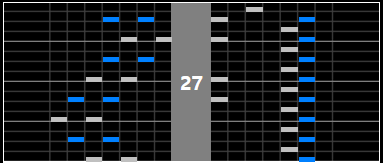
As I said, my ring finger is usually in charge of buttons 5 and 6. It’s actually very effective and stable at handling dense patterns; however, in patterns like above (5-6 trill or 5-6 chords) there is a lot of pressure on the hands.
Of course, you can use the ring finger slide technique – sliding your ring finger up and down buttons 5 and 6, but if possible, I recommend you switch to a different hand position to handle these. (In reality, I still stick to the ring finger slides when I don’t have the opportunity to switch to a different playstyle when high density patterns appear).
Middle-5 technique
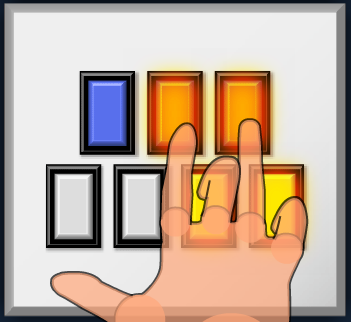
Middle-5 position refers to when the middle finger is in charge of button 5 by bending down the finger, and hitting button 6 with your ring finger.
Using this technique, you can handle 5-6 trills and 5-6 chords with stability, compared to the ring slide technique. For example, in the case of 3-5-6 chord, if you try to use ring slide (sliding from 6 => 5), your thumb and the ring finger will end up next to each other (on 3 and 5). If you use middle-5 instead, then you can cleanly handle the 3-5-6 chord without this happening. The main merit of middle-5 is that you can handle 3-5-6 chord as a chord.
Middle 5 may cause your hand to shift from center to right side, relative to the keys. This means that you may end up using the index finger to hit 4, due to the slight shift. If you see a 4-5-6 chord or high density stream with 4-5-6-7, then you are able to do a 1:1 assignment of your fingers to buttons 4-7. This means that if you get a pattern that is heavily focused on the right side of the keys, then middle-5 is extremely effective.
Example: Insomnia DPA
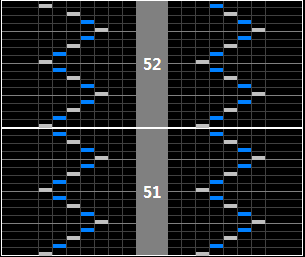
The difficulty with middle-5 is that learning to bend the middle finger downwards is very tricky, since it’s unnatural. For 2-5-6 chord as an example, your index will hit 2 and middle will hit 5 - forcibly spreading them apart, which is quite uncomfortable. Additionally, once you use middle-5 technique, the entire hand tend to shift to the right, so there are difficulties in gradually moving it back to the center position.
Putting it together, I think learning middle 5 is recommended, but not a requirement. Of course, middle 5 can be comfortable if you get used to it, but it is actually unstable as the primary playstyle for high-density patterns. It causes your hand to move to the right and make your hands unnatural, causing all of your fingers move longer distances. In summary, middle 5 should be used as a secondary style to augment your primary playstyle.
In my case, I tried to get used to this at ★6, but I was already too used to the ring slide technique. Only when I was about to hard clear all of ★12 I was able to effectively use middle-5. Even then, that’s only my right hand; my left hand uses the ring slide technique quite often.
Middle-6 technique
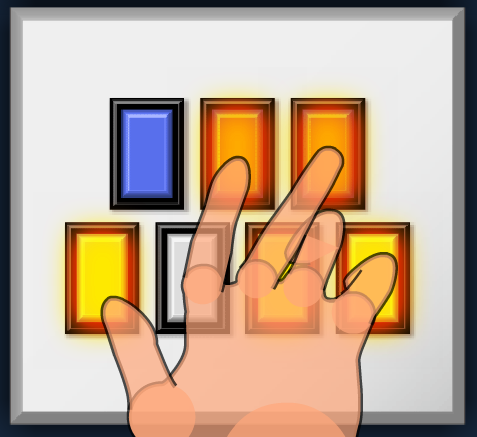
Middle-6 is the opposite of of middle-5. As you can see above, the middle finger is stretched out to hit button 6, while the ring finger bends downwards to handle button 5. Middle-6 is more comfortable than middle-5; it also does not deviate too heavily from the basic hand position, so it can be used even in high-density patterns.
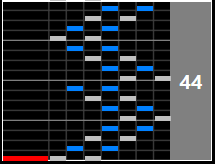
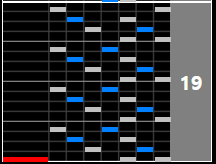
Middle 6 is especially effective at double stairs. In contrast to the ring slide, you can handle double-stair patterns without having to use the same finger twice in a row. In the example above – MENDES SPA and Verflucht SPA – if you were to one-hand these, you can imagine middle-6 being much more comfortable than middle-5 or ring slide.
In addition to double stairs, but also various chords patterns could be handled easily by middle-6 compared to middle-5. Depending on individuals preference, in the case of 1-2-5-6-7 or 2-3-5-6 chords, middle-6 is slightly more comfortable.
I first learned about middle-6 in one-hand top ranker CELI’s MENDES SPA Hard-clear video. You can watch how to use at 0:33~ and 1:44~. See here for video. I was shocked then, since I could not even imagine that the middle finger could be used to hit button 6.
Meanwhile, you may have difficulties getting used to the idea that ring and the middle fingers are flipped compared to the basic position. Furthermore, only when you start playing high density patterns you start to recognize the strengths of middle-6; conversely, before you play high level charts, there aren’t many charts where you will feel the need to learn middle-6.
In summary, middle-6 is a very powerful hand position for high-density patterns or chord-heavy patterns – but it’s very difficult to get used to. There is the tendency for one-hand players make heavy use of middle-6, but DP players typically use middle-5.
In my case, I cannot use middle-6. I tried to learn at some point, but middle-5 and ring slide techniques have been sufficient. I do think that I might need it one day, though.
Thumb-5 technique
Thumb-5 is the technique of hitting button 5 with your thumb. While both middle-5 and middle-6 encourage a somewhat unnatural hand position, using thumb-5 allows you to hit 5-6 chords with ease just by bringing your fingers together.

Thumb-5 is very effective when you handle chords like 2-4-5-6 chord like you see above. 2-4-5-6 chord is one of the most difficult 4-note chords, as you cannot handle this perfectly with both middle-5 or middle-6. However, if you simply use your thumb to hit 5, it becomes much easier.
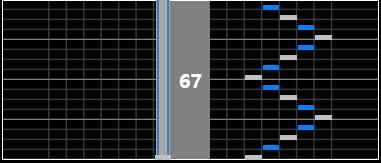
In addition to chord patterns, high density patterns focus on the right side (see image above) also call for thumb-5 technique.

Also, you can handle simple double stairs in the picture above with thumb-5, because you don’t need to move your ring or middle fingers downwards
Moving your thumb to button 5 causes your hands to shift much more than what you would for middle-5 and middle-6. It limits your hand’s ability to hit general high-density patterns. Therefore, you need to use it as a secondary playstyle in addition to a primary style.
Pinky-5 technique

Pinky-5 was devised to cleanly hit 2-4-5-6 chord. As you read above, 2-4-5-6 chord can be handled with thumb-5, but thumb needs to travel a long distance. To overcome this challenge, pinky-5 can be used instead of thumb-5.

Pinky 5 is very effective at chord-based patterns like Nageki No Ki SPA shown above. These kind of patterns are difficult to hit without the pinky-5 technique.
You can see pinky-5 in CELI’s POINT ZERO SPA video.
Personally, I think pinky-5 is better than thumb 5 when you need to hit 2-4-5-6 chord. This is because the less your fingers move away from the base position, the more your fingers remain flexible. Pinky-5 make your fingers move less than thumb-5; it helps you handle various patterns naturally.
Thumb slide technique
That was enough about button 5 - let’s talk about button 3 instead.
Thumb slide means sliding your thumb around to hit button 1 and 3. It means that for 1-2-3 chords, you are using thumb-index-thumb (TL note: similar to thumb-index-thumb / 3:5 style used in SP).
Typically, you would bend down your middle finger to hit button 3 in a 1-2-3 chord… but this causes your hand to become unbalanced when you are in the middle of handling high-density patterns, moving away from buttons button 4,5,6,7. As an alternative, using the thumb slide prevents your hand from losing the center balance.
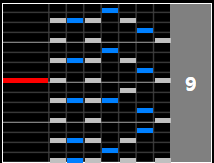
It is very effective at some patterns like AA SPA above. 1-2-3 chords like this may put a lot of strain on your hands if you use your middle finger to hit 3. However, if you use the thumb slide technique, you can comfortable hit these kind of patterns. AA SPA non-random has a lot of 1-2-3 chords so this is a good pattern to learn how to thumb slide.
When you reach ★12 or ☆12 DBM is when you start really feeling the need for thumb slide. This is because you will rarely ever encounter 1-2-3 chords before reaching that level, but when you are at that level, you see them all the time.
In my case, AA Another DBM was very helpful in getting used to thumb slide.
Conclusion
In this article, I have covered basically all DP hand positions that are typically used. Honestly, I think that middle-5 and ring slide are enough to handle ordinary DP patterns until ★13 – without the need for middle-6 or pinky-5.
If you can use various hand positions as I introduced, you may be handle wider range of patterns. But if you want to improve beyond ★13, you’d better get used to these hand positions and improve your skills by playing DBM, DBR, or playing one-handed SP.
I’m going to tell you specialized hand positions next time.
References
This is a direct translation of ereter’s article, translation done by Horie.
